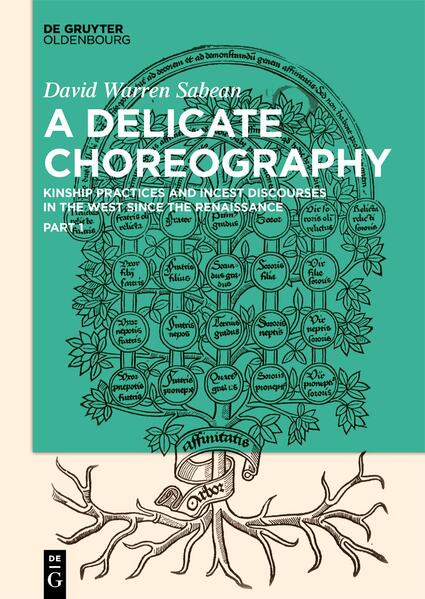A Delicate Choreography
Sabean, David
(24.10.2023)
Verlag: De Gruyter Oldenbourg
Author: Sabean, David
ISBN: 978-3-11-100924-7
Erscheinungsdatum: 24.10.2023
The origins of the incest taboo have puzzled many of the most influential minds of the West, from Plutarch to St. Augustine, St. Thomas Aquinas, Martin Luther, David Hume, Lewis Henry Morgan, Sigmund Freud, Emile Durkheim, Edward Westermarck, and Claude Lévi-Strauss. This book puts the discussion of incest on a new foundation. It is the first attempt to thoroughly examine the rich literature, from philosophical, theological, and legal treatises to psychological and biological-genetic studies, to a wide variety of popular cultural media over a long period of time. The book offers a detailed examination of discursive and figurative representations of incest during five selected periods, from 1600 to the present. The incest discussion for each period is complemented with a presentation of dominant kinship structures and changes, without arguing for causal relations.
Part I deals with the legacy of ecclesiastical marriage prohibitions of the Middle Ages: Historians dealing with the Reformation have wondered about the political and social implications of theological debates about the incest rules, the Enlightenment opted for sociological considerations of the household and a new anthropology based on the passions, Baroque discourse focused upon sexual relations among kin by marriage , while Enlightenment and Romantic discussions worried the intimacy of siblings.
The first section of Part II deals with the six decades around 1900, during which European and American cultures obsessed about the sexuality of women. Almost everyone concurred in the idea that mother made the family what it was; that she configured the household, kept the lines of kinship vibrant, and stood at the threshold as stern gatekeeper, and many thought that she managed these tasks through her sexuality and an eroticized relationship with sons. Another story line, taken up in the section "Intermezzo," this one about the physical and mental consequences of inbreeding, appeared after 1850. To what extent do close-kin marriages pose risks for progeny? At its center, lay the incest problematic, now restated: Is avoidance of kin genetically programmed? Do all cultures know about risks of consanguinity? As for the twenty-first century, evolutionary and genetic assumptions are challenged by a living world population containing roughly one billion offspring of cousin marriages.
Part III deals with one of the perhaps most remarkable reconfigurations of Western kinship in the aftermath of World War I: The shift from an endogamous to an exogamous alliance system centered on the "nuclear family." An historical anomaly, this family form began to dissolve almost as soon as it came together and, in the process, shifted the focus of incest concerns to a new pairing: father and daughter. By the 1970s, when the father/daughter problematic swept all other considerations of incest aside, that relationship had come to be modeled, for the most part, around power and its abusive potential. As for "incest," its representations in the last three decades of the twentieth century no longer focused on biologically damaged progeny but rather on power abuses in the nuclear family: sexual "abuse." By the mid-1990s, Western culture at least partly redirected its gaze away from father and daughter towards siblings, especially towards brothers and sisters and the sexual boundaries and erotics of their relationships. Correspondingly, siblings became a "model organism" for psychotherapy, evolutionary biology, and the science of genetics.
Biographie - Sabean, David
David Warren Sabean, Henry J. Bruman Endowed Professor Emeritus of German History, Department of History, UCLA, Los Angeles.Rezensionen "A Delicate Choreography"
Part I
***
"This is a brilliant book that deals with far more than incest. The author analyses countless literary texts, unveils the hidden premises of scholarly debates, and traces the making of anxieties and taboos. He mobilizes tools of cultural history to answer a fundamental question of social history: How were societies since the Middle Ages transformed?" – Simon Teuscher, Professor for Medieval History, University of Zurich
***
Part II
***
"In this second part of his epic trilogy on Kinship Practices and Incest Discourses in the West since the Renaissance, David Sabean’s bow stretches from literary descriptions of mother-son relations to the biology of sexuality and reproduction as seen by the medical sciences, from the interrelation between nature and nurture to the geneticization of incest. The undertaking is as daring as it testifies to the mastery of the author. David Sabean’s opus magnum is the fascinating fruit of a life-long effort to understand Western kinship structures and practices." – Hans-Jörg Rheinberger, Max Planck Institute for the History of Science
***
"Taboos on marriages between close relatives were based on moral, social, and political grounds long before incest became a biological issue and taboos were justified by the deleterious mental and physical effects of such liaisons on the next generation. How this change came about in Western societies is one of a myriad of fascinating questions addressed in this monumental history of incest." – Soraya de Chadarevian, University of California
***
Part III
***
"A virtuoso performance by David Sabean, one of the world's most accomplished social historians. Many have critiqued biologically reductionist accounts of incest prohibitions, but who else could shed light on the current media obsession with erotic relations between siblings by placing it in a lineage with medieval takes on impediments to marriage, Baroque conceptions of prudence, the late-20th-century proliferation of family forms, and the impact of theoretical trends in the social sciences? His elegantly argued account links historical shifts in the scope and application of rules about incest to matters that go well beyond the household, placing concerns about social reproduction at the heart of the perpetual reconfiguration of intimacies." – Kath Weston, Professor of Anthropology, University of Virginia and British Academy Global Professor, Social Anthropology, University of Edinburgh
| Hauptlesemotive: | Verstehen |
|---|---|
| Nebenlesemotive: | Auseinandersetzen |
| Produktart: | Buch |
Anmelden


